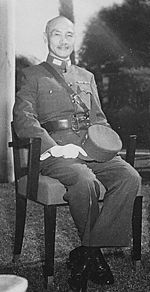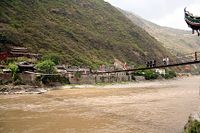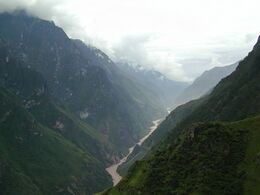المسيرة الطويلة
| ||||||||||||||||||||||||||
| ||||||||||||||||||||||||||
المسيرة الطويلة Long March (أكتوبر 1934 – أكتوبر 1936) كانت تقهقراً عسكرياً قام به الجيش الأحمر للحزب الشيوعي الصيني، سلف جيش التحرير الشعبي، to evade the pursuit of the كومنتانگ (KMT or Chinese Nationalist Party) army. There was not one Long March, but a series of marches, as various Communist armies in the south escaped to the north and west. The best known is the march from جيانگشي province which began in October 1934. The First Front Army of the Chinese Soviet Republic, led by an inexperienced military commission, was on the brink of annihilation by Generalissimo Chiang Kai-shek's troops in their stronghold في مقاطعة جيانگشي. The Communists, under the eventual command of Mao Zedong and Zhou Enlai, escaped in a circling retreat to the west and north, which reportedly traversed over 9,000 kilometers (5600 miles) over 370 days.[1] The route passed through some of the most difficult terrain of western China by traveling west, then north, to شآنشي.
The Long March began Mao Zedong's ascent to power, whose leadership during the retreat gained him the support of the members of the party. The bitter struggles of the Long March, which was completed by only about one-tenth of the force that left جيانگشي، would come to represent a significant episode in the history of the Communist Party of China, and would seal the personal prestige of Mao Zedong and his supporters as the new leaders of the party in the following decades.
. . . . . . . . . . . . . . . . . . . . . . . . . . . . . . . . . . . . . . . . . . . . . . . . . . . . . . . . . . . . . . . . . . . . . . . . . . . . . . . . . . . . . . . . . . . . . . . . . . . . . . . . . . . . . . . . . . . . . . . . . . . . . . . . . . . . . . . . . . . . . . . . . . . . . . . . . . . . . . . . . . . . . . . .
خط زمني
- 1931: Unofficial founding of the جيانگشي–Fujian Soviet by Mao Zedong and Zhu De.
- 1931: December, Zhou Enlai arrived in Ruijin and replaced Mao as leader of the CCP.
- 1932: October, at the Ningdu Conference, the majority of CCP military leaders criticized Mao's tactics; Mao was demoted to figurehead status.
- 1933: Bo Gu and Otto Braun arrived from the USSR, reorganized the Red Army; and took control of Party affairs. They defeated four encirclement campaigns.
- 1933: September 25, the حملة الإحاطة الخامسة started. Bo and Braun were eventually defeated.
- 1934: October 16, 130,000 soldiers and civilians, led by Bo Gu and Otto Braun, began the Long March.
- 1934: November 25 – December 3, Battle of Xiang River.
- 1935: January 15–17, Zunyi Conference. The leadership of Bo and Braun was denounced. Zhou became the most powerful person in the Party; Mao became Zhou's assistant.
- 1935: June–July, troops under Zhou and Mao met with Zhang Guotao's troops. The two forces disagreed on strategy, and separated.
- 1935: April 29 – May 8, crossing of the Jinsha River, the upper stream of the Yangtze River.
- 1935: May 22, Yihai Alliance, the red army allied with the Yi people.
- 1935: May 29, CCP forces captured Luding Bridge.
- 1935: July, CCP forces crossed the Jade Dragon Snow Mountains.
- 1935: August, CCP forces crossed the Zoigê Marsh.
- 1935: September 16, CCP forces crossed the Lazikou Pass.
- 1935: October 22, three Red Army fronts met في شآنشي. The Long March ended.
- 1935: November, Mao became the leader of the CCP. Zhou became Mao's assistant.
الخلفية
الجيش الأحمر في 1934
الحرب الأهلية
 مقالة مفصلة: الحرب الأهلية الصينية
مقالة مفصلة: الحرب الأهلية الصينية
سوڤيت جيانگشي
 مقالة مفصلة: سوڤيت جيانگشي-فوجيان
مقالة مفصلة: سوڤيت جيانگشي-فوجيان
محاولات تشيانگ للمحاوطة
 مقالة مفصلة: حملات المحاوطة
مقالة مفصلة: حملات المحاوطة
المسيرة الطويلة
الهروب من جيانگشي
الإفلات من ملاحقة تشيانگ
النزاع مع زعماء الحرب من الأقليات
الجيش الأحمر الرابع
الجيش الأحمر الثاني
اتحاد الجيوش الثلاث
الأعقاب
| “ | أعظم تراجع استراتيجي في التاريخ العسكري حوّل ماو إلى أسطورة حية. | ” |
— رودريك مكفاركوهار، ماو تسى تونگ: امبراطور الصين الفلاح، A&E Biography, 2005[2] | ||
. . . . . . . . . . . . . . . . . . . . . . . . . . . . . . . . . . . . . . . . . . . . . . . . . . . . . . . . . . . . . . . . . . . . . . . . . . . . . . . . . . . . . . . . . . . . . . . . . . . . . . . . . . . . . . . . . . . . . . . . . . . . . . . . . . . . . . . . . . . . . . . . . . . . . . . . . . . . . . . . . . . . . . . .
انظر أيضاً
- تاريخ الصين
- تاريخ جمهورية الصين
- تاريخ جمهورية الصين الشعبية
- List of Battles of Chinese Civil War
- Military of the People's Republic of China
- Military of the Republic of China
- National Revolutionary Army
- جيش التحرير الشعبي
- Warlord Era
- Whampoa Military Academy
References
- ^ Zhang, Chunhou. Vaughan, C. Edwin. [2002] (2002). Mao Zedong as Poet and Revolutionary Leader: Social and Historical Perspectives. Lexington books. ISBN 0-7391-0406-3. pg 65.
- ^ Biography (TV series) – Mao Tse Tung: China's Peasant Emperor, A&E Network, 2005, ASIN B000AABKXG
للاستزادة
- Chang, Jung; Halliday, Jon (2005). Mao: The Unknown Story. Alfred A. Knopf. pp. 814 pages. ISBN 0-679-42271-4.
{{cite book}}: Unknown parameter|lastauthoramp=ignored (|name-list-style=suggested) (help) - Griffith, Samuel B. (translator) (2005). Yu Chi Chan (On Guerrilla Warfare) by Mao Tse-tung (1937). Dover Books on History. pp. 128 pages. ISBN 0-486-44376-0.
{{cite book}}:|last=has generic name (help) - Jocelyn, Ed & McEwen, Andrew (March 2006). The Long March. Constable and Robinson. pp. 320 pages. ISBN 1-84529-255-3.
{{cite book}}: CS1 maint: multiple names: authors list (link) - Kampen, Thomas (2000). Mao Zedong, Zhou Enlai and the Evolution of the Chinese Communist Leadership. Nordic Institute of Asian Studies. pp. 66–83. ISBN 87-87062-76-3.
- King, Dean (2010). Unbound: A True Story of War, Love, and Survival. Little, Brown and Company. pp. 432 pages. ISBN 978-0-316-16708-6.
- Bosshardt, Rudolf Alfred (1975). The Guiding hand: Captivity and Answered Prayer in China. Hodder and Stoughton. pp. 192 pages. ISBN 978-0340175453.
- Salisbury, Harrison Evans (1985). The Long March : The Untold Story. Harper & Row, New York. pp. 419 pages. ISBN 0-06-039044-1.
- Shuyun, Sun (2008). The Long March: The True History of Communist China's Founding Myth. Anchor. p. 304. ISBN 0-307-27831-X.
- Snow, Edgar (1968). Red Star Over China (Revised ed.). Grove Press. pp. 534 pages. ISBN 0-8021-5093-4.
- Whitson, William W. (1973). The Chinese High Command : A History of Communist Military Politics 1927–71. Praeger. ISBN 0-333-15053-8.
- Wilson, Dick (1971). The Long March 1935: The Epic of Chinese Communism's Survival. Penguin Press. pp. 283 pages. ISBN 0-14-006113-4.
- Yang, Benjamin (1990). From Revolution to Politics: Chinese Communists on the Long March. Westview Press. pp. 240 pages. ISBN 0-8133-7672-6.
- Young, Helen Prager (2000). Choosing Revolution: Chinese Women Soldiers on the Long March. University of Illinois Press, pp. 282 pages. ISBN 978-0-252-07456-1
وصلات خارجية
- معلومات عامة
- Key events of the Long March – Account of the Long March by the China Daily
- Retracing Mao's Long March – Report on the modern expeditions by Jocelyn & McEwen along the Long March routes
- The Myth of the 'Turning-Point': Towards a New Understanding of the Long March – Article from 'Bochumer Jahrbuch zur Ostasienforschung' (2001)
- Illustrations, Maps & Posters
- Map of primary route – Locations of the First Front Army route with dates
- Long March routes of the Communist armies – Routes of the First, Second and Fourth Front Armies
- Site of the Zunyi Conference – Photo and description of the building in which the landmark 1935 politburo meeting was held
- Luding Bridge – Chinese propaganda posters depicting the battle for Luding Bridge
- Commemorations
- The Long March: 70 Years On – Official Chinese website marking the 70th Anniversary of Long March
- "Marking the 70th anniversary of the victory of the Red Army's Long March" – PLA Daily (Peoples Liberation Army newspaper) web portal
- Art on a Long March – A contemporary art exhibition presented for the public at sites along the route of Mao's Long March.




